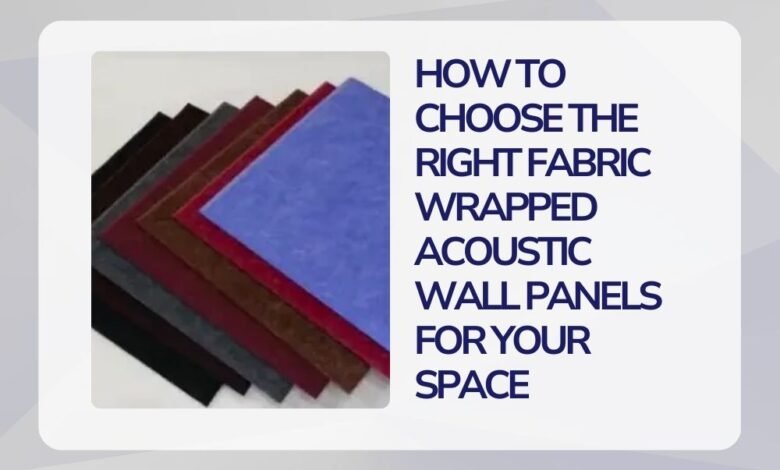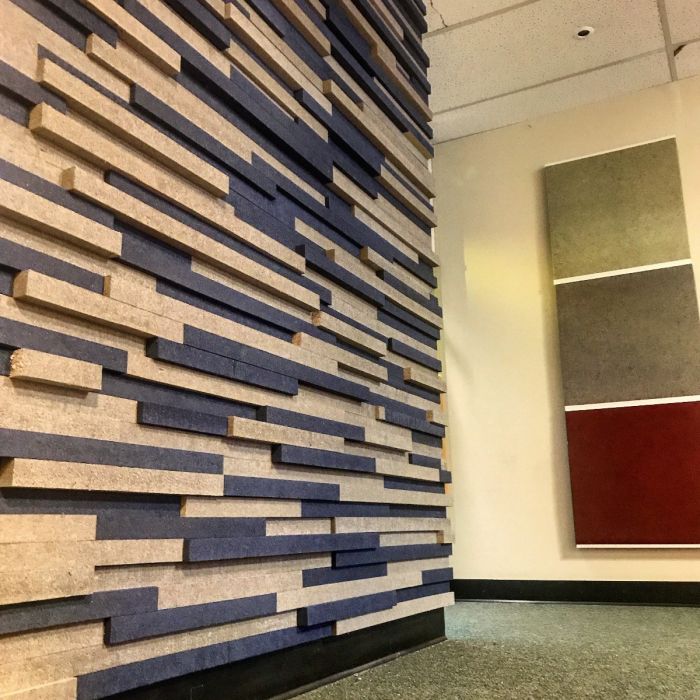How to Choose the Right Fabric Wrapped Acoustic Wall Panels for Your Space
Fabric Wrapped Acoustic Wall Panels

Acoustic control has become a key element in both residential and commercial spaces. Whether it’s a home theater, office, conference room, or music studio, sound quality plays a significant role in how we experience a space. Poor acoustics can lead to unwanted noise, echoes, or even difficulty in understanding conversations. One solution that has gained popularity is fabric wrapped acoustic wall panels. These panels not only help with noise control but also add an aesthetic appeal to the room. However, choosing the right ones for your specific needs can be tricky. In this guide, we will help you understand how to choose the right fabric wrapped acoustic wall panels for your space.
Understanding the Purpose of Acoustic Wall Panels
Before diving into how to choose fabric wrapped acoustic wall panels, it’s important to understand their purpose. Acoustic panels are designed to absorb sound waves and reduce echo, reverberation, and noise. They work by converting sound energy into heat energy, making the room sound clearer and less chaotic. Whether you’re dealing with soundproofing or improving the sound quality within a room, acoustic wall panels can be a key element in achieving the right balance.
Note – Looking to enhance the sound quality and aesthetics of your space? Discover how fabric wrapped acoustic wall panels from Perfect Acoustics can transform your environment with effective noise control and stylish design. Whether it’s for your home, office, or studio, these panels provide the perfect balance between functionality and elegance. Visit Perfect Acoustics today to explore the ideal solution for your acoustic needs!
Fabric wrapped acoustic panels are unique because they are covered in a layer of fabric, which not only contributes to sound absorption but also enhances the visual appeal of the space. They come in a variety of colors, textures, and patterns, making it possible to match them with your room’s interior design. While the main function of these panels is to improve sound quality, they also serve a decorative purpose. Hence, it’s essential to think about both the acoustic performance and aesthetic value when choosing panels for your space.

Identify the Acoustic Needs of Your Space
The first step in choosing the right fabric wrapped acoustic wall panels is identifying the specific acoustic needs of your space. Different rooms have different sound requirements, and understanding these needs will help you make a more informed choice. For instance, a home theater will need more robust sound absorption to ensure high-quality sound, while an open office may require panels that help reduce background noise without completely isolating conversations.
In small rooms with a lot of hard surfaces, echoes and reverberation tend to be a bigger issue. Fabric wrapped acoustic panels can absorb these sound reflections and create a more balanced auditory experience. For larger rooms or rooms with high ceilings, the problem may not be just echoes but overall noise reduction, which means you might need panels that cover a larger surface area. Taking the time to assess your space’s specific acoustic challenges will ensure you choose panels that meet your needs efficiently.
Choose the Right Fabric for Your Acoustic Panels
Once you’ve identified your space’s acoustic needs, it’s time to focus on the fabric used in your acoustic panels. The fabric covering plays a significant role not only in the appearance of the panels but also in their performance. Thicker fabrics generally provide better sound absorption, while lighter fabrics may offer a sleek look but slightly less noise control. The most common materials for fabric wrapped acoustic panels include polyester, wool, and blends of synthetic fibers.
One important factor to consider is the fabric’s breathability. For effective sound absorption, the fabric should allow sound waves to pass through it and be absorbed by the material inside the panel. Tightly woven fabrics may hinder this process, reducing the panel’s ability to absorb sound. On the other hand, loosely woven fabrics can enhance the sound-absorbing capabilities. Additionally, if you want your acoustic panels to last long, choose fabrics that are durable and resistant to wear and tear, especially if the panels will be installed in high-traffic areas like offices or public spaces.
Consider the Aesthetics of the Panels
While the acoustic performance of the panels is crucial, don’t overlook their visual impact. Fabric wrapped acoustic wall panels offer a lot of flexibility when it comes to design. You can choose from a variety of colors, textures, and patterns to match the decor of your space. Some people opt for neutral colors to blend seamlessly into the room, while others choose bold designs to make a statement.
If you’re installing the panels in a home theater or music studio, you may want to create a sleek, modern look with darker fabrics. On the other hand, for offices or conference rooms, lighter and more professional tones like gray, white, or beige can offer a clean and sophisticated appearance. The fabric’s texture also plays a role in the room’s visual appeal. For example, a smooth fabric can give a contemporary look, while a textured fabric can add warmth and depth. When choosing the aesthetics of your panels, remember that the fabric should complement the overall interior design of the room without compromising the panel’s acoustic functionality.
Determine the Placement and Size of the Panels
Another important aspect of choosing the right fabric wrapped acoustic wall panels is determining where to place them and how large the panels should be. The placement of the panels directly affects how well they can control sound in a room. Typically, panels are placed on walls that are most prone to sound reflection, such as those opposite speakers or windows. For rooms with high ceilings or large windows, placing panels on both the walls and ceilings can help reduce reverberation and create a more controlled sound environment.
In terms of size, larger panels will cover more surface area and provide better sound absorption, making them ideal for big spaces. However, in smaller rooms, several small panels strategically placed can work just as effectively. It’s important to find the right balance between the number and size of panels to avoid overwhelming the room visually while still achieving the desired acoustic performance. Custom-sized panels are also available if your space requires a unique solution.
Think About Installation and Maintenance
Before purchasing fabric wrapped acoustic wall panels, consider how they will be installed and maintained. Some panels come with easy installation options, such as adhesive backing or mounting brackets, while others may require professional installation, especially if you are covering a large area. Make sure to check the installation requirements before making your final decision to avoid any unexpected complications.
In terms of maintenance, fabric wrapped acoustic panels are relatively easy to take care of. However, the fabric can accumulate dust or stains over time, especially in high-traffic areas. Look for panels with fabrics that are easy to clean, or consider adding a protective coating to extend their lifespan. In areas where hygiene is a concern, such as hospitals or schools, you may also want to choose fabrics that are antimicrobial or resistant to mold and mildew.
Budget Considerations
Finally, budget plays an important role in your decision-making process. Fabric wrapped acoustic wall panels come in a wide range of prices, depending on the size, fabric quality, and acoustic performance. While it’s tempting to go for the most affordable option, remember that higher-quality panels will provide better sound absorption and last longer, making them a more cost-effective solution in the long run.
It’s important to strike a balance between your budget and your room’s acoustic needs. For example, you might choose to install fewer high-quality panels rather than filling a room with cheaper, less effective ones. Take the time to compare options and consult with acoustic experts if necessary to find the best solution for your space within your budget.
Conclusion
Choosing the right fabric wrapped acoustic wall panels for your space requires careful consideration of several factors, from the acoustic needs of the room to the fabric type, panel placement, and aesthetics. By taking the time to assess these elements and making informed decisions, you can achieve both effective sound control and a visually pleasing environment. Remember, the right panels will not only enhance the auditory experience in your space but also contribute to the overall design and comfort of the room.
For more insightful articles related to this topic, feel free to visit toastul.com

